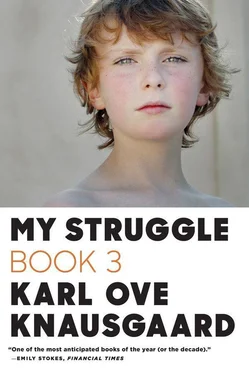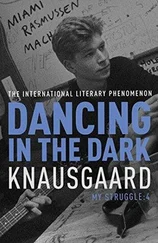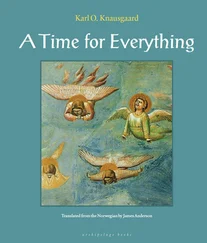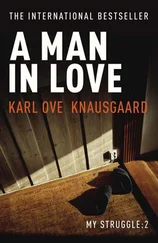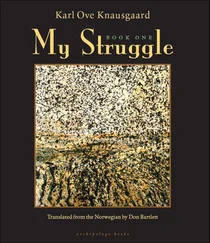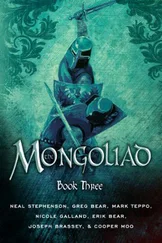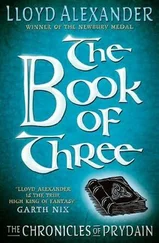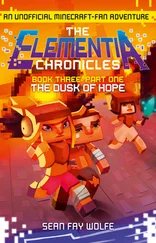“Quiet, Alex!” Dag Lothar would say, as he came running up the narrow gravel path from the cellar door or rushing from the front door.
“You’re frightening Karl Ove with your barking, you stupid dog.”
“I’m not frightened,” I would counter. Dag Lothar would just look at me with a kind of stiff smile, which meant “Don’t give me that.”
Then off we went.
Where did we go?
Into the forest.
Down to Ubekilen, to a bay.
Down to the pontoons.
Up to Tromøya Bridge.
Down to Gamle Tybakken.
Over to the plastic boat factory.
Up into the hills.
Along to Lake Tjenna.
Up to B-Max.
Down to the Fina gas station.
Unless, that is, we just ran about in the road where we lived, or hung around outside one of the houses there, or sat on the curb, or in the big cherry tree no one owned.
That was everything. That was the world.
But what a world!
An estate has no roots in the past, nor any branches into the skies of the future, as satellite towns once had. Estates arrived as a pragmatic answer to a practical question, where are all the people moving into the district going to live, ah yes, in the forest over there, we’ll clear some plots and put them up for sale. The only house there belonged to a family called Beck; the father was Danish and had built the house himself in the middle of the forest. They didn’t have a car, or a washing machine, or a television. There was no garden, only a drive made from pounded soil in among the trees. Piles of wood under tarpaulins and, in the winter, an upturned boat. The two sisters, Inga Lill and Lisa, went to the local middle school and looked after Yngve and me for the first years we lived there. Their brother was called John, he was two years older than me, wore strange, homemade clothes, wasn’t in the slightest bit interested in what we were interested in, and devoted his attention to other matters, which he never told us about. He built his own boat when he was twelve. Not like us, not like the rafts we tried to cobble together from dreams and a lust for adventure, but a proper, real rowboat. You would have thought he would be bullied, but he wasn’t, in a way, the distance was too great. He wasn’t one of us and he didn’t want to be. His father, the cycling Dane, who perhaps had nurtured an urge to live alone in the middle of the forest ever since his time in Denmark, must have been mortified when the plans for the estate were drawn up and approved and the first construction machinery rolled into the forest just beyond his house. The families who moved in were from all over the country and all of them had children. In the house across the road lived Gustavsen, he was a fireman, she was a housewife, they came from Honningsvåg, their children were called Rolf and Leif Tore. In the house opposite us lived Prestbakmo, he was a schoolteacher, she was a nurse, they came from Troms, their children’s names were Gro and Geir. On the same side was Kanestrøm, he worked at the post office, she was a housewife, they came from Kristiansund, their children were called Steinar, Ingrid Anne, Dag Lothar, and Unni. On the other side was Karlsen, he was a sailor, she was a shop assistant, they were from Sørland, their children were Kent Arne and Anne Lene. Above them was Christensen, he was a sailor, I don’t know what she did, their children were called Marianne and Eva. On the other side lived Jacobsen, he was a typographer, she was a housewife, both were from Bergen, their children were Geir, Trond, and Wenche. Above them, Lindland, from Sørland, their children were Geir Håkon and Morten. Around there, I began to lose track, at least as far as the parents’ names and jobs were concerned. The children there were: Bente, Tone Elisabeth, Tone, Liv Berit, Steinar, Kåre, Rune, Jan Atle, Oddlaug, and Halvor. Most were my age, the oldest seven years above me, the youngest four years below. Five of them would later be in my class.
We moved there in the summer of 1970, when most of the houses on the site were still being built. The shrill warning siren, which sounded before an explosion, was a common feature of my childhood, and that very distinctive feeling of doom you can experience when the shock waves from the explosion ripple through the ground causing the floor of the house to tremble was common, too. It was natural to think of connections above the ground — roads, electric cables, forests, and seas — but more disturbing to think of them being beneath the ground as well. What we stood on, shouldn’t that be absolutely immovable and impenetrable? At the same time all the openings in the ground had a very special fascination for me and the other children I grew up with. It was not uncommon for us to flock around one of the many holes being dug in our area, whether for sewage pipes or electric cables, or for the foundations of a cellar, and to stare down into the depths, yellow where there was sand, black, brown, or reddish brown where there was soil, gray where there was clay, and sooner or later the bottom was always covered with an opaque layer of grayish-yellow water, its surface sometimes broken by the top of a huge rock or two. Above the hole towered a shiny yellow or orange excavator, not unlike a bird, with its bucket like a beak at the extreme end of a long neck, and beside it a stationary truck, with headlights like eyes, the radiator grille like a mouth, and the tarpaulin-covered rear, a back. In the case of large construction projects there would also be bulldozers or dump trucks, usually yellow, with enormous wheels and treads that were a hand’s width. If we were lucky we would find piles of detonation cord in or near the hole, which we pinched because the cord had a high swap and utility value. Besides this, there were normally drums nearby, the height of a man, wooden bobbin-like constructions from which cables were unfurled, and piles of smooth, reddish-brown plastic pipes measuring the approximate diameter of our forearms. There were further piles of cement pipes and precast cement wells, so rough and wonderful, a bit taller than us, perfect for climbing on; long, immovable mats of old, cut-up car tires, which they used during the blasting; mounds of wooden telephone poles, green from the preservative they had been impregnated with; boxes of dynamite; sheds where the workmen changed their clothes and ate. If they were there we kept a respectful distance and watched what they were doing. If they weren’t, we clambered down the holes, onto the dump-truck wheels, balanced on the piles of pipes, rattled the shed doors and peered through the windows, jumped down into the cement wells, tried to roll the drums away, filled our pockets with cable clippings, plastic handles, and detonation cord. In our world no one had greater status than these workmen; no work seemed more meaningful than theirs. The technical details were of no interest to me, they meant as little as the make of the construction machines. What fascinated me most, apart from the changes in the landscape the workmen wrought, were the manifestations of their private lives that came with them. When one of them produced a comb from his orange overalls or baggy, almost shapeless, blue trousers and combed his hair, safety helmet under his arm, amid all the droning and pounding of the machines, for example, or the mysterious, indeed almost incomprehensible, moment when the workmen emerged from the shed in the afternoon wearing absolutely normal clothes and got into their cars and drove off like absolutely normal men.
There were other workmen we watched closely, indefatigably. If anyone from Televerket appeared in the vicinity, the news spread like wildfire among the groups of children. There was the car, there was the workman, a telecom engineer, and there were his fantastic climbing shoes! With those on his feet and a tool belt around his waist he clicked on a harness that went around both him and the pole, and then, with a series of slow and deliberate, but for us completely mystifying, movements he began to mount the pole. How was this possible ? Straight-backed, with no visible sign of effort, no visible use of force, he glided up to the top. Wide-eyed, we stared at him while he worked aloft. Not one of us would leave because soon he would be climbing down again, in the same easy, effortless, incomprehensible way. Imagine having shoes like those, with the curved metal hook that wrapped itself around the post, what couldn’t you do?
Читать дальше
